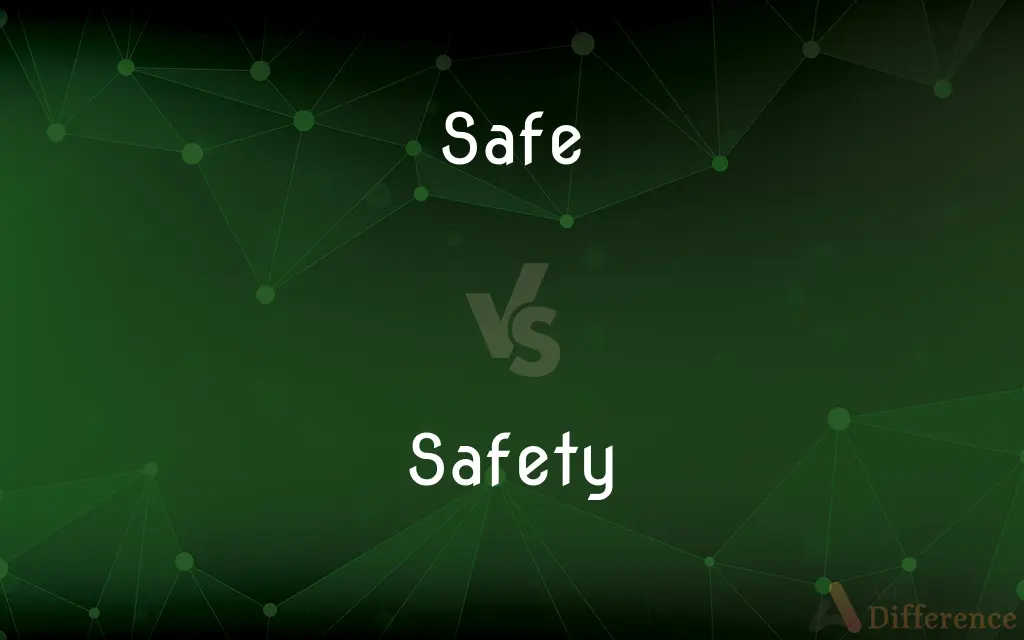Safe vs. Safety — What's the Difference?
Edited by Tayyaba Rehman — By Maham Liaqat — Updated on March 17, 2024
Safe is an adjective describing a state free from danger or harm, while safety refers to the condition of being protected from harm or other non-desirable outcomes.

Difference Between Safe and Safety
Table of Contents
ADVERTISEMENT
Key Differences
Safe, as an adjective, characterizes something that does not pose any threat or danger, emphasizing a secure state or environment. For example, a safe neighborhood is one where the risk of harm is minimal. Safety, however, is a noun that represents the overall condition or practice of being secure from threats and harm. It encapsulates a broader range of practices, measures, and conditions aimed at preventing injury or danger.
When we consider products or places, describing them as "safe" implies they are unlikely to cause harm or danger. For instance, a safe car has features that protect its occupants. On the other hand, safety in this context refers to the protocols, features, and designs implemented to ensure the car's occupants are protected from harm, such as safety belts and airbags.
In terms of personal well-being, feeling safe is a subjective experience that indicates an absence of perceived threat, while personal safety involves practical steps and precautions taken to protect oneself from potential harm.
The concept of safe emphasizes the end result or state — being free from danger. In contrast, safety focuses on the ongoing efforts and considerations that create and maintain a secure environment.
Safe is used more often to describe conditions or actions that inherently do not present danger, such as safe handling procedures. Safety, conversely, is the overarching principle or concept that guides such procedures and measures, underlining the importance of preventing danger or harm.
ADVERTISEMENT
Comparison Chart
Part of Speech
Adjective
Noun
Definition
Being free from danger or harm
The condition of being protected from harm
Focus
Describes a state or condition
Refers to measures, conditions, or practices
Application
Used to describe objects, environments, actions
Refers to concepts, systems, protocols
Example Usage
This bridge is safe to cross.
Workplace safety is our top priority.
Compare with Definitions
Safe
Not causing or free from danger or risk.
The company ensures that all its toys are safe for children.
Safety
The condition of being protected from or unlikely to cause danger, risk, or injury.
Safety measures were enhanced following the recent accident.
Safe
A place or receptacle to keep valuable items secure.
He stored the documents in a safe to protect them from theft.
Safety
The concept or practice of safe and secure conditions in various environments.
Road safety has improved with the new traffic management system.
Safe
Secure and protected against criminal activity.
She felt safe walking home after the neighborhood watch program was initiated.
Safety
A reference to the protocols and measures taken to ensure protection and prevent accidents.
Fire safety training is mandatory for all new employees.
Safe
Unlikely to cause or lead to harm.
It's safe to eat the leftovers if they've been properly refrigerated.
Safety
Equipment designed to protect people from harm or injury.
Safety gear is required at all times on the construction site.
Safe
Denoting something that can be done without risk of adverse consequences.
It's safe to say he won't be joining us after the argument.
Safety
The state of feeling protected from harm or danger.
The safety of our guests is always our first concern.
Safe
A safe (also called a strongbox or coffer) is a secure lockable box used for securing valuable objects against theft and/or damage from fire. A safe is usually a hollow cuboid or cylinder, with one face being removable or hinged to form a door.
Safety
Safety is the state of being "safe", the condition of being protected from harm or other danger. Safety can also refer to the control of recognized hazards in order to achieve an acceptable level of risk.
Safe
Free from danger or injury; undamaged or unhurt
He returned from the voyage safe and sound.
Safety
The condition of being safe; freedom from danger, risk, or injury.
Safe
Not exposed to the threat of danger or harm
The children were safe at home all through the storm.
Safety
A device designed to prevent accidents, as a lock on a firearm preventing accidental firing.
Safe
Usable in specified conditions without being damaged. Often used in combination
A microwave safe container.
Safety
A play in which a member of the offensive team downs the ball or is tackled or forced out of bounds behind his own goal line, resulting in two points for the defensive team.
Safe
Free from risk; not liable to be lost; sure
A safe bet.
Safety
Either of two defensive backs normally positioned behind the linebackers in the middle of the backfield.
Safe
Affording protection
A safe place.
Safety
The condition or feeling of being safe; security; certainty.
If you push it to the limit, safety is not guaranteed.
Safe
(Baseball) Having reached a base without being put out, as a batter or base runner.
Safety
(mechanics) A mechanism on a weapon or dangerous equipment designed to prevent accidental firing.
Be sure that the safety is set before proceeding.
Safe
A metal container usually having a lock, used for storing valuables.
Safety
(American football) An instance of a player being sacked or tackled in the end zone, or stepping out of the end zone and off the field, resulting in two points to the opposite team.
He sacked the quarterback in the end zone for a safety.
Safe
A repository for protecting stored items, especially a cooled compartment for perishable foods
A cheese safe.
Safety
(American football) Any of the defensive players who are in position furthest from the line of scrimmage and whose responsibility is to defend against passes as well as to be the tacklers of last resort.
The free safety made a game-saving tackle on the runner who had broken past the linebackers.
Safe
Not in danger; out of harm's reach.
You’ll be safe here.
Safety
(baseball) A safety squeeze.
Safe
Free from risk.
It’s safe to eat this.
Safety
Preservation from escape; close custody.
Safe
Providing protection from danger; providing shelter.
We have to find a safe spot, where we can hide out until this is over.
Safety
(dated) A safety bicycle.
Safe
(baseball) When a batter successfully reaches first base, or when a baserunner successfully advances to the next base or returns to the base he last occupied; not out.
The pitcher attempted to pick off the runner at first, but he was safe.
Safety
(transitive) To secure (a mechanical component, as in aviation) to keep it from becoming detached even under vibration.
Safe
In a location that renders it difficult to hit with the cue ball.
Safety
To secure a firing pin, as in guns, to keep the gun from firing
Safe
Properly secured.
The documents are safe.
Safety
The condition or state of being safe; freedom from danger or hazard; exemption from hurt, injury, or loss.
Up led by thee,Into the heaven I have presumed,An earthly guest . . . With like safety guided down,Return me to my native element.
Safe
Not susceptible to a specified source of harm.
Safety
Preservation from escape; close custody.
Imprison him, . . . Deliver him to safety; and return.
Safe
Great, cool, awesome, respectable; a term of approbation, often as interjection.
Safety
The act or result of a ball-carrier on the offensive team being tackled behind his own goal line, or the downing of a ball behind the offensive team's own goal line when it had been carried or propelled behind that goal line by a player on the offensive tream; such a play causes a score of two points to be awarded to the defensive team; - it is distinguished from touchback, when the ball is downed behind the goal after being propelled there or last touched by a player of the defending team. See Touchdown. Same as Safety touchdown, below.
Safe
(slang) Lenient, usually describing a teacher that is easy-going.
Safety
Short for Safety bicycle.
Safe
Reliable; trusty.
Safety
A switch on a firearm that locks the trigger and prevents the firearm from being discharged unintentionally; - also called safety catch, safety lock, or lock.
Safe
Cautious.
Safety
The state of being certain that adverse effects will not be caused by some agent under defined conditions;
Insure the safety of the children
The reciprocal of safety is risk
Safe
(programming) Of a programming language, type-safe or more generally offering well-defined behavior despite programming errors.
Safety
A safe place;
He ran to safety
Safe
A box, usually made of metal, in which valuables can be locked for safekeeping.
Safety
A device designed to prevent injury
Safe
(slang) A condom.
Safety
(baseball) the successful act of striking a baseball in such a way that the batter reaches base safely
Safe
(dated) A ventilated or refrigerated chest or closet for securing provisions from noxious animals or insects.
Safety
A score in American football; a player is tackled behind his own goal line
Safe
A safety bicycle.
Safe
(transitive) To make something safe.
Safe
Free from harm, injury, or risk; untouched or unthreatened by danger or injury; unharmed; unhurt; secure; whole; as, safe from disease; safe from storms; safe from foes.
They escaped all safe to land.
Established in a safe, unenvied throne.
Safe
Conferring safety; securing from harm; not exposing to danger; confining securely; to be relied upon; not dangerous; as, a safe harbor; a safe bridge, etc.
The King of heaven hath doomedThis place our dungeon, not our safe retreat.
Safe
Incapable of doing harm; no longer dangerous; in secure care or custody; as, the prisoner is safe.
But Banquo's safe?Ay, my good lord, safe in a ditch he bides.
Safe
A place for keeping things in safety.
Safe
To render safe; to make right.
Safe
Strongbox where valuables can be kept safe
Safe
A ventilated or refrigerated cupboard for securing provisions from pests
Safe
Free from danger or the risk of harm;
A safe trip
You will be safe here
A safe place
A safe bet
Safe
Of an undertaking
Safe
Having reached a base without being put out;
The runner was called safe when the baseman dropped the ball
Safe
Financially sound;
A good investment
A secure investment
Safe
In safekeeping;
Your secret is safe with me
Common Curiosities
How do safety measures contribute to a place being safe?
Safety measures, such as protocols and equipment, directly contribute to creating and maintaining environments that are safe by minimizing risks and protecting individuals.
Is safety always guaranteed when safety measures are in place?
While safety measures significantly reduce risks, they cannot guarantee absolute safety due to the unpredictable nature of accidents and human error.
Why is safety important in the workplace?
Safety in the workplace is crucial to prevent accidents, injuries, and illnesses, ensuring the well-being of employees and the continuity of business operations.
Can a place be considered safe but have poor safety measures?
Yes, a place might be considered safe due to low incident rates but could still have inadequate safety measures, which might not address potential risks properly.
What role do governments play in ensuring safety?
Governments enforce regulations and standards that define safety measures for various sectors, including transportation, construction, and food safety, to protect the public.
What is the difference between safe and safety?
Safe describes a condition free from danger, while safety refers to the state or measures taken to protect from harm.
What makes a product safe?
A product is considered safe if it's designed and manufactured in a way that minimizes the risk of injury or harm to the user.
How can individuals contribute to their own safety?
Individuals can contribute to their own safety by following established safety guidelines, using protective equipment, and being aware of their environment to avoid hazards.
What is a safety culture?
A safety culture refers to the shared values, beliefs, and practices within an organization that prioritize safety as an integral part of daily operations.
Can technology improve safety?
Technology can significantly improve safety through innovations like safety apps, monitoring systems, and advanced protective equipment that mitigate risks.
Share Your Discovery

Previous Comparison
Era vs. Kra
Next Comparison
Drab vs. InsipidAuthor Spotlight
Written by
Maham LiaqatEdited by
Tayyaba RehmanTayyaba Rehman is a distinguished writer, currently serving as a primary contributor to askdifference.com. As a researcher in semantics and etymology, Tayyaba's passion for the complexity of languages and their distinctions has found a perfect home on the platform. Tayyaba delves into the intricacies of language, distinguishing between commonly confused words and phrases, thereby providing clarity for readers worldwide.















































